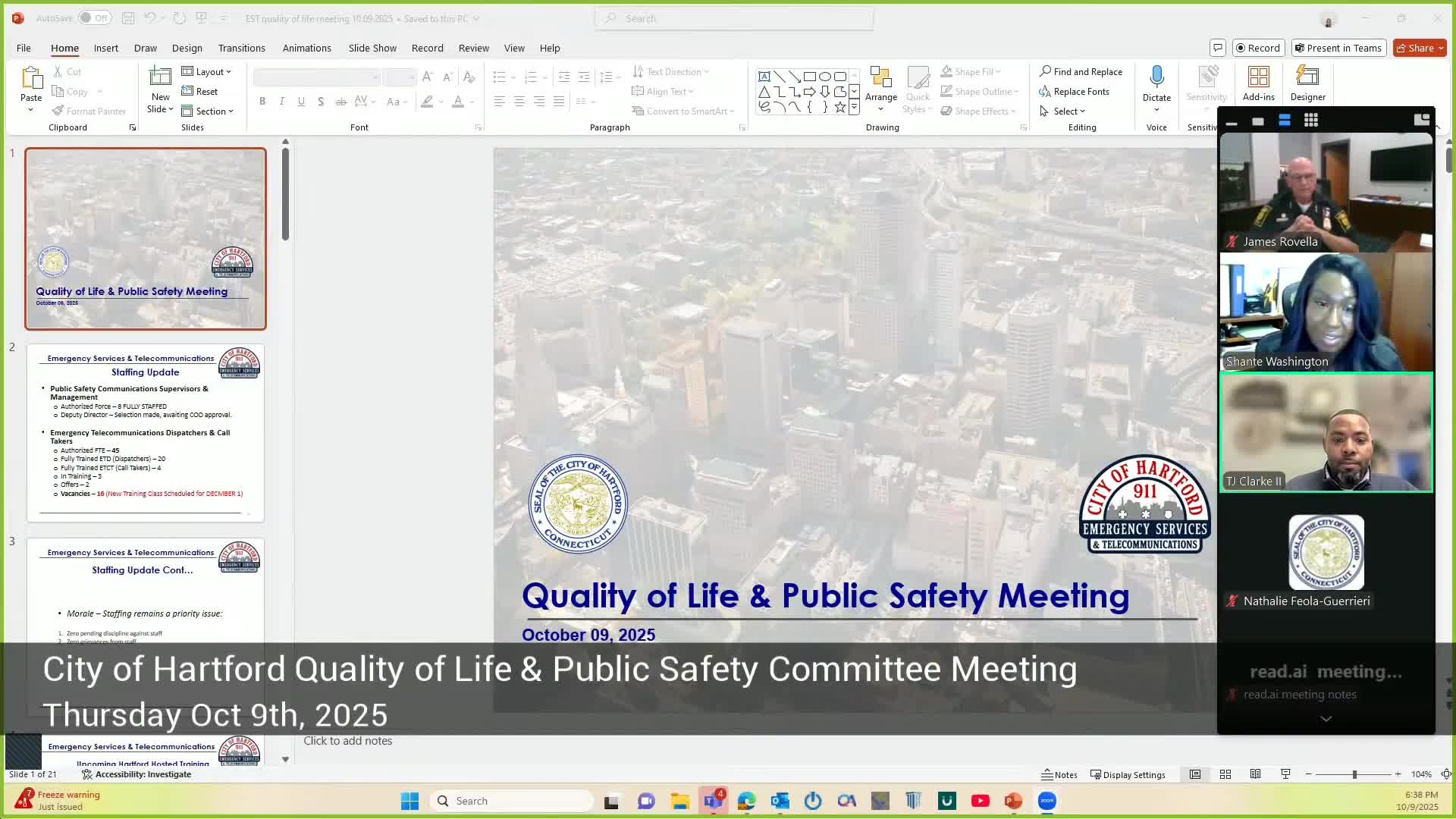Emergency Services & Telecommunications reports staffing gaps, training and CAD/AMR integration delays
October 10, 2025 | Hartford City, Hartford County, Connecticut
This article was created by AI summarizing key points discussed. AI makes mistakes, so for full details and context, please refer to the video of the full meeting. Please report any errors so we can fix them. Report an error »

Shante Washington, quality assurance coordinator for Hartford’s Emergency Services and Telecommunications (ES&T), told the Quality of Life and Public Safety Committee Thursday that the department remains understaffed in dispatch and is pursuing multiple training and technology initiatives while continuing partnerships for mental-health and quality-of-life responses.
Washington said supervisors are authorized at eight positions (two are new hires), and that the department has 45 authorized dispatch/call-taker slots but only 20 fully trained dispatchers and four fully trained call takers; three staff are in training, two offers are outstanding and 16 vacancies remain. She said ES&T has a targeted December 1 start date for the next recruit class.
Why it matters: Dispatch staffing levels and technology interoperability directly affect 911 call-handling and emergency response coordination. Washington also described training offerings and partnerships that reduce the burden on uniformed units.
Training and partnerships: ES&T is organizing a homicide-class session Nov. 12–13 with 31 registered participants and plans additional offerings with the Denise Amberly Foundation and the New England Leadership Academy. Washington said Director Cavallo (presenting offsite) will speak at an invitation-only public-safety leadership conference this weekend about a proposed federal change (S. 725 referenced in the presentation) to classify public-safety telecommunicators as protective-service occupations in the federal Standard Occupational Classification system.
Technology and Heart Team: Washington said the CAD-to-CAD interoperability project with AMR is underway but delayed because of an AMR hub issue; the radio-infrastructure cutover is scheduled for January 2026 and funding was not reported as affected. She described the Heart Team partnership (CRT/Wheeler Clinic) that responds to nonviolent quality-of-life calls and wellness checks; the team typically operates Monday–Friday, uses radios, and usually fields two units (CRT1, CRT2) that can be dispatched by police radio.
Discussion and follow-up: Committee members asked how and when the Heart Team is dispatched and whether they respond in the absence of officers or EMS; Washington said the team is dispatched to nonviolent calls and does respond when EMS is not needed, and that police remain available to assist when required. ES&T plans to continue recruitment, training, and technology work and will report progress on class start dates and interoperability testing.
Sources and attribution: All direct figures and program descriptions come from Shante Washington’s ES&T briefing to the committee on 10/09/2025.
Washington said supervisors are authorized at eight positions (two are new hires), and that the department has 45 authorized dispatch/call-taker slots but only 20 fully trained dispatchers and four fully trained call takers; three staff are in training, two offers are outstanding and 16 vacancies remain. She said ES&T has a targeted December 1 start date for the next recruit class.
Why it matters: Dispatch staffing levels and technology interoperability directly affect 911 call-handling and emergency response coordination. Washington also described training offerings and partnerships that reduce the burden on uniformed units.
Training and partnerships: ES&T is organizing a homicide-class session Nov. 12–13 with 31 registered participants and plans additional offerings with the Denise Amberly Foundation and the New England Leadership Academy. Washington said Director Cavallo (presenting offsite) will speak at an invitation-only public-safety leadership conference this weekend about a proposed federal change (S. 725 referenced in the presentation) to classify public-safety telecommunicators as protective-service occupations in the federal Standard Occupational Classification system.
Technology and Heart Team: Washington said the CAD-to-CAD interoperability project with AMR is underway but delayed because of an AMR hub issue; the radio-infrastructure cutover is scheduled for January 2026 and funding was not reported as affected. She described the Heart Team partnership (CRT/Wheeler Clinic) that responds to nonviolent quality-of-life calls and wellness checks; the team typically operates Monday–Friday, uses radios, and usually fields two units (CRT1, CRT2) that can be dispatched by police radio.
Discussion and follow-up: Committee members asked how and when the Heart Team is dispatched and whether they respond in the absence of officers or EMS; Washington said the team is dispatched to nonviolent calls and does respond when EMS is not needed, and that police remain available to assist when required. ES&T plans to continue recruitment, training, and technology work and will report progress on class start dates and interoperability testing.
Sources and attribution: All direct figures and program descriptions come from Shante Washington’s ES&T briefing to the committee on 10/09/2025.
Don't Miss a Word: See the Full Meeting!
Go beyond summaries. Unlock every video, transcript, and key insight with a Founder Membership.
✓
Get instant access to full meeting videos
✓
Search and clip any phrase from complete transcripts
✓
Receive AI-powered summaries & custom alerts
✓
Enjoy lifetime, unrestricted access to government data
30-day money-back guarantee

